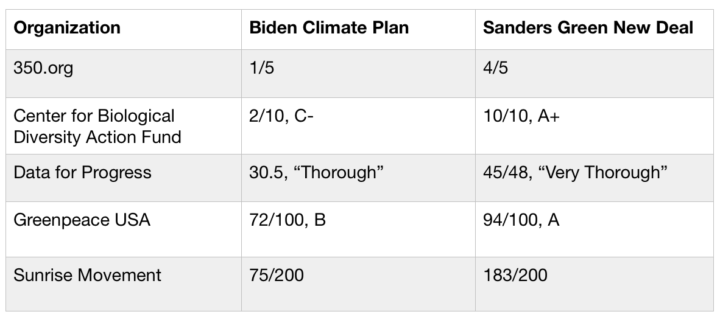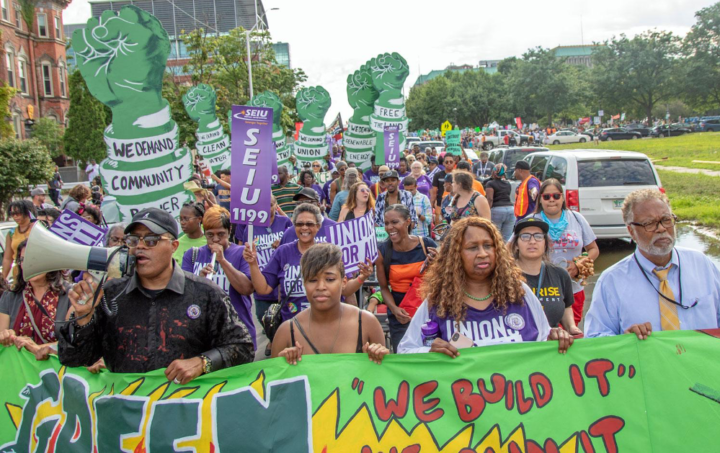By Jean Willoughby
Against the odds, a youth-led mobilization succeeded in placing the climate crisis at the forefront of the 2020 election season. We didn’t get a full-fledged climate debate, but we did get the Climate Crisis Town Hall, helpfully hosted and paywalled by CNN. Despite this warm, generous embrace from the Democratic National Committee and mainstream media, in a few short years the grassroots efforts of groups like the Sunrise Movement left established think tanks in the dust and sparked a resurgence of interest in climate policy. Catalyzed by young climate activists, an outpouring of new articles, books, and videos has engaged millions of people in mapping out a future free of fossil fuels.
After healthcare, climate change ranks as the second-most important issue to Democrats. Even as an economic recession threatens amid the coronavirus pandemic, the climate remains a top concern. For the first time in 20 years, a majority of Americans say that climate change should be a national priority for the government—a 14 percentage point increase over the response to the same survey four years ago. Close to two-thirds, 64 percent, say environmental protection should be a top priority, comparable to the 67 percent who say strengthening the economy should be paramount. People of color, whose turnout will make or break future elections for Democrats, overwhelmingly support environmental protection and government action on climate change (and do so at significantly higher rates than whites). In 2020, one-third of eligible voters will be people of color. Let’s look at what leading Democrats have to offer climate voters, which is to say most Americans.
Last year, Democratic presidential candidates released climate plans that would usher in a progressive, scientifically-merited upgrade to the Democratic Party’s platform, which in 2016 called for “getting 50 percent of our electricity from clean energy sources within a decade.” After months of debate, by March there were two candidates left on the stage—Joe Biden and Bernie Sanders—representing profoundly different visions for how the U.S. government should lead on the most important issues of our time. Sanders, who announced on April 8th that he is suspending his campaign but will remain on the ballot to earn delegates, will continue to be a powerful figure in shaping the overall direction of the party and perhaps also Biden’s platform going into the election. Despite their obvious ideological divide, Biden and Sanders do agree on a few things.
Biden and Sanders concur on recommitting to the Paris accords, which aim to keep global temperature increases to at or below 1.5 degrees Celsius. (While it’s a critical target, climate journalist Bill McKibben points out that it’s a rather modest goal, considering how rapidly climate change is altering our world.) Two other areas where the two strongly align are on ending fossil fuel subsidies and helping former industry workers as well as their communities transition to a renewable energy economy. Biden and Sanders each offer a set of progressive proposals with accompanying budgets that raise eyebrows, if for different reasons.
Biden’s climate plan would invest $1.7 trillion over 10 years to reach net-zero carbon emissions in the United States no later than 2050. It claims that the outlay would spur “additional private sector and state and local investments to total to more than $5 trillion.” Biden says his plan will be paid for by “reversing the excesses of the Trump tax cuts for corporations,” fighting tax evasion, and ending fossil fuel subsidies. With or without the extra help, this level of investment is likely too small to reach the big goals promised in Biden’s plan, not that the issue isn’t important to him. Biden wants voters to know that climate change is an “existential threat” and that he has something of a track record on the issue.
Sanders released a $16.3 trillion plan to achieve net zero by 2030 and to fully decarbonize the economy by 2050. In keeping with the spirit of his campaign, which sought to achieve a fundamental reordering of our national priorities, Sanders adopted the title of the original Green New Deal resolution. Even if pared down, the plan seeks to overhaul how energy is generated and exchanged in the country. Sanders has stated that his plan would be paid for through at least six major sources: federal projects that earn income by generating affordable electricity for millions of people, ending tax breaks to the fossil fuels industry, creating an estimated 20 million new jobs that contribute taxes, cutting $1.215 trillion from “military spending on protecting the global oil supply,” ending tax cuts for the ultra-wealthy, and establishing a progressive tax system. Sanders also asserts that his plan will pay for itself within 15 years.
The issue of how to move beyond fossil fuels is emblematic of Biden’s incrementalism and Sanders’s progressivism. Biden fortified his stance on oil and gas drilling, saying in the last debate that he would allow “no new fracking” for natural gas. A Sanders plan would ban the practice. While Biden refers to the Green New Deal as a “crucial framework,” he hasn’t committed to several of its major planks, causing him to struggle with climate-minded voters and younger voters who could play a decisive role in the coming election. The activist group U.S. Youth Climate Strike recently announced that it would not endorse Biden. As of April 12th, over 50 student and youth-led groups have followed their lead, the majority announcing the decision on Twitter.
An influential voice among progressive voters, Representative Alexandria Ocasio-Cortez has repeatedly questioned Biden’s plan, recently tweeting that it represents a “form of denialism.”
$1.7T is not enough to tackle climate change.
Inadequate climate plans are a form of denialism over how bad this problem really is.
My generation & future ones will have to contend with the horrifying mess that the cowardly leadership of previous ones left us. It’s a betrayal.
— Alexandria Ocasio-Cortez (@AOC) March 16, 2020
Biden will have to work hard to address the skepticism of younger voters, but they’ve offered him some pointers on how to earn their votes. In contrast, Sanders was able to build trust with voters of all ages by staying the course, stressing time and again that climate change is both a moral crisis and a national security threat requiring seismic government intervention, to the point of declaring it a national emergency. The strategy here is simple: Demand the best. In seeking to establish a gold standard, Sanders has already been able to redefine the realm of possibility on other issues, notably healthcare.
The climate keeps score, so do voters
It almost feels silly to place such extremely divergent proposals side-by-side for comparison. But since the future of our planet is at stake, let’s. Below are the climate scorecards of several major environmental nonprofits and think tanks.

Sunrise Movement rates candidates partly on how and how much they talk about climate change. Like minutes devoted to a debate topic, word count can also be taken as one measure of concern. Biden’s plan is around 10,200 words. Sanders’s is close to 14,000. As Washington Governor and former presidential candidate Jay Inslee’s 170-page climate opus proves, they could both provide a bit more detail. Elizabeth Warren’s approach to weaving climate policy throughout her platform also demonstrates how we might better integrate our strategies for tackling this most multifaceted of challenges.
Right now, another crisis is wreaking havoc on the lives of millions around the world. Much like climate change, the coronavirus pandemic imposes a punishing multiplier effect on other social problems. As it continues to reveal how vulnerable the richest nation in the world has become, it has strengthened the resolve of Democratic voters, a majority of whom now support another signature Sanders proposal, Medicare for All. That shift could signal a greater openness to using government as a tool to solve system-wide problems and to innovate in the economy at large.
In March, over 10 million Americans filed for unemployment largely due to the coronavirus pandemic. The Federal Reserve estimates that 47 million or more could lose their jobs by the end of June, leading some to call for a federal jobs guarantee and green jobs legislation as part of the major investments that are likely necessary to maintain America’s infrastructure during the crisis. Now is the time to translate the macroeconomics of the Green New Deal, much of which both candidates support, into kitchen-table policies that working families desperately need.
Biden, double, or nothing?
Biden claims that his climate plan will create 10 million new jobs. Sanders says his will create 20 million. Voters in dozens of states still have the chance to send a message about which they prefer. With Sanders leaving the campaign trail, the torch passes to climate voters to advocate for the best their country can do.
Jean Willoughby is a writer and a contributor to Pressenza.






